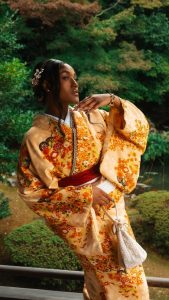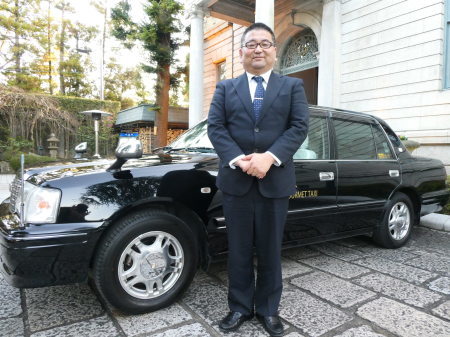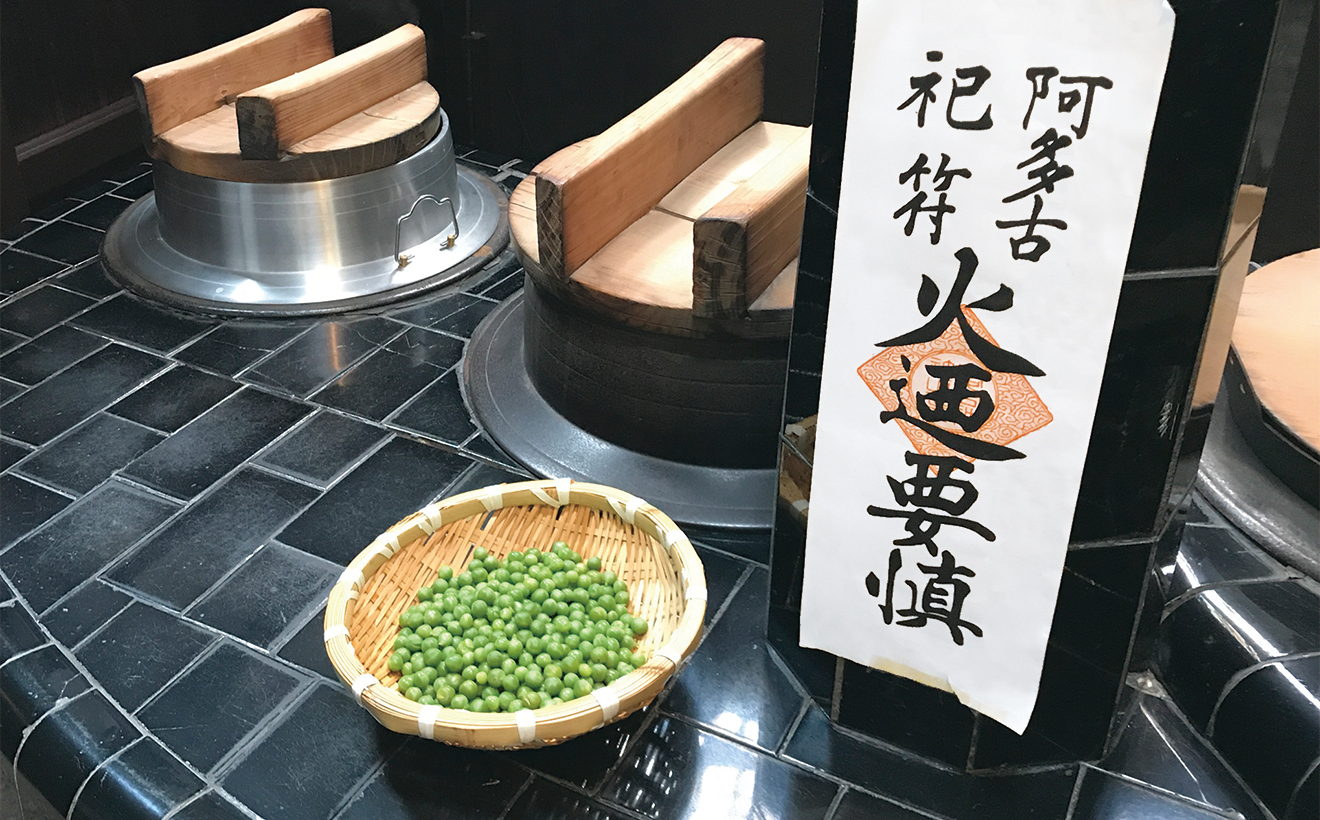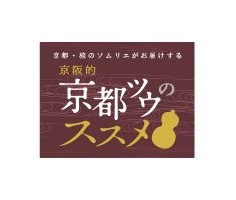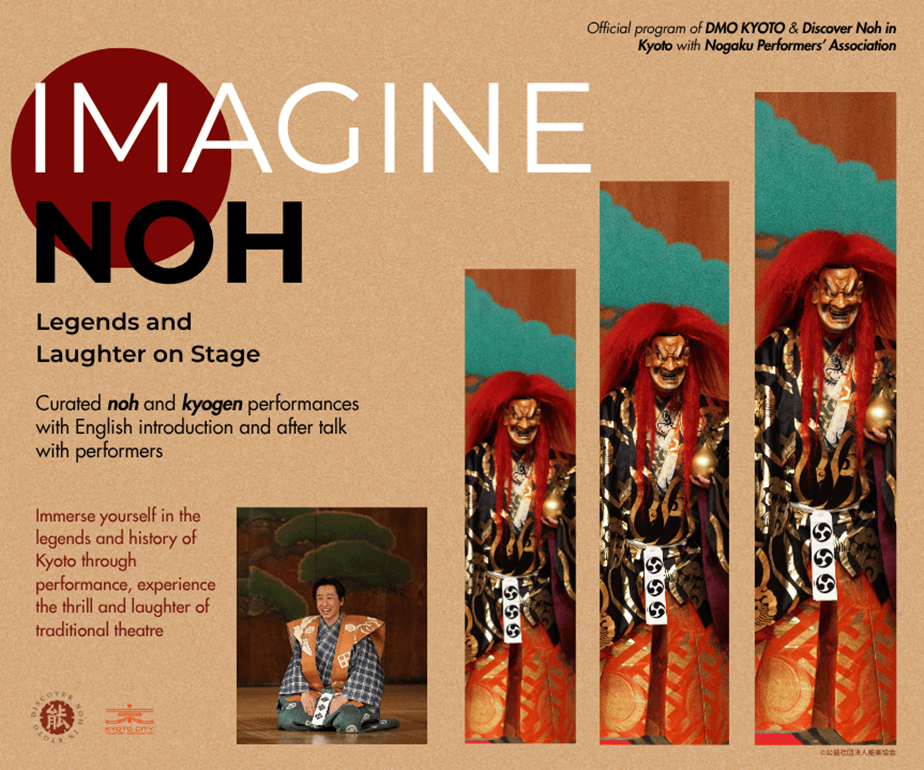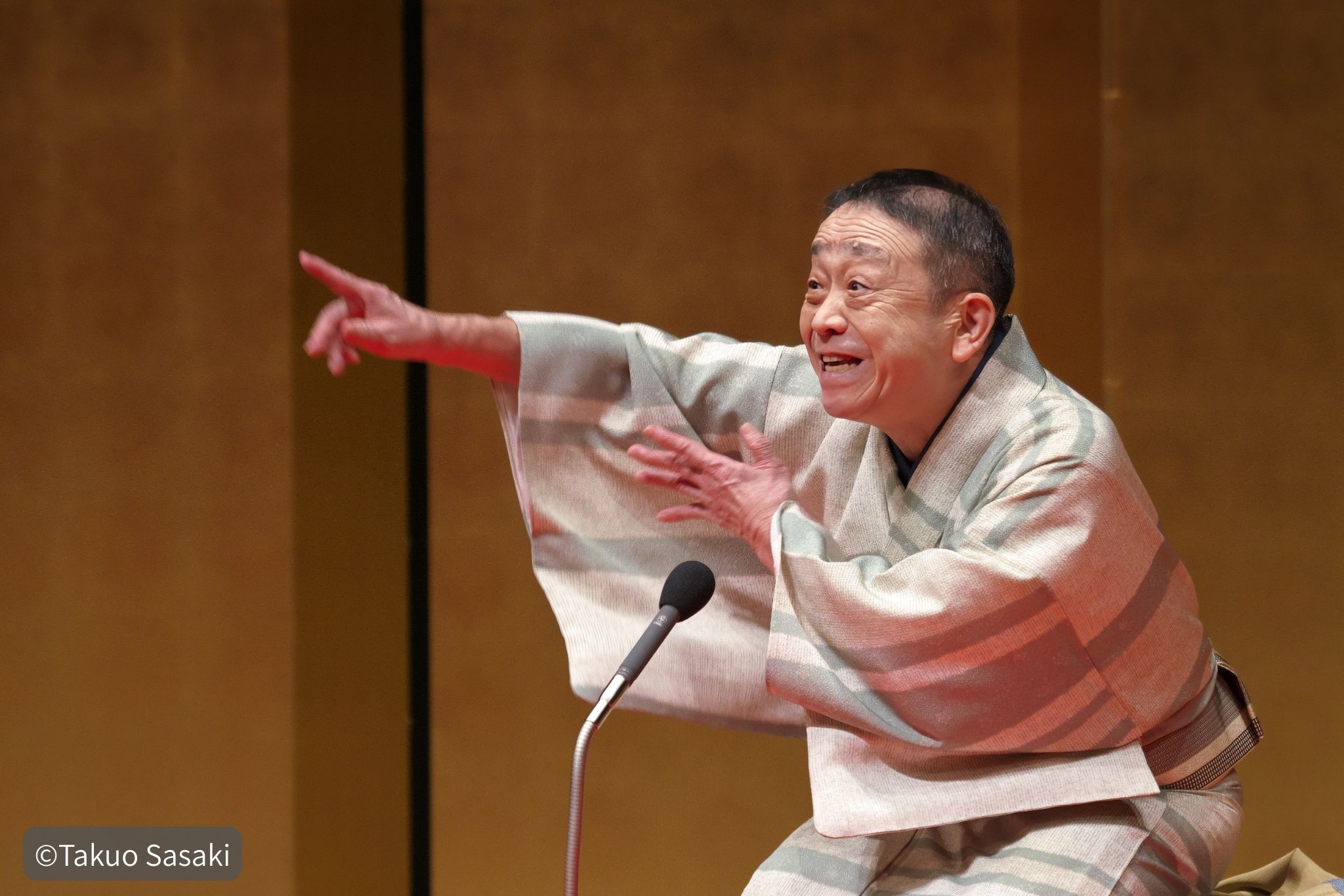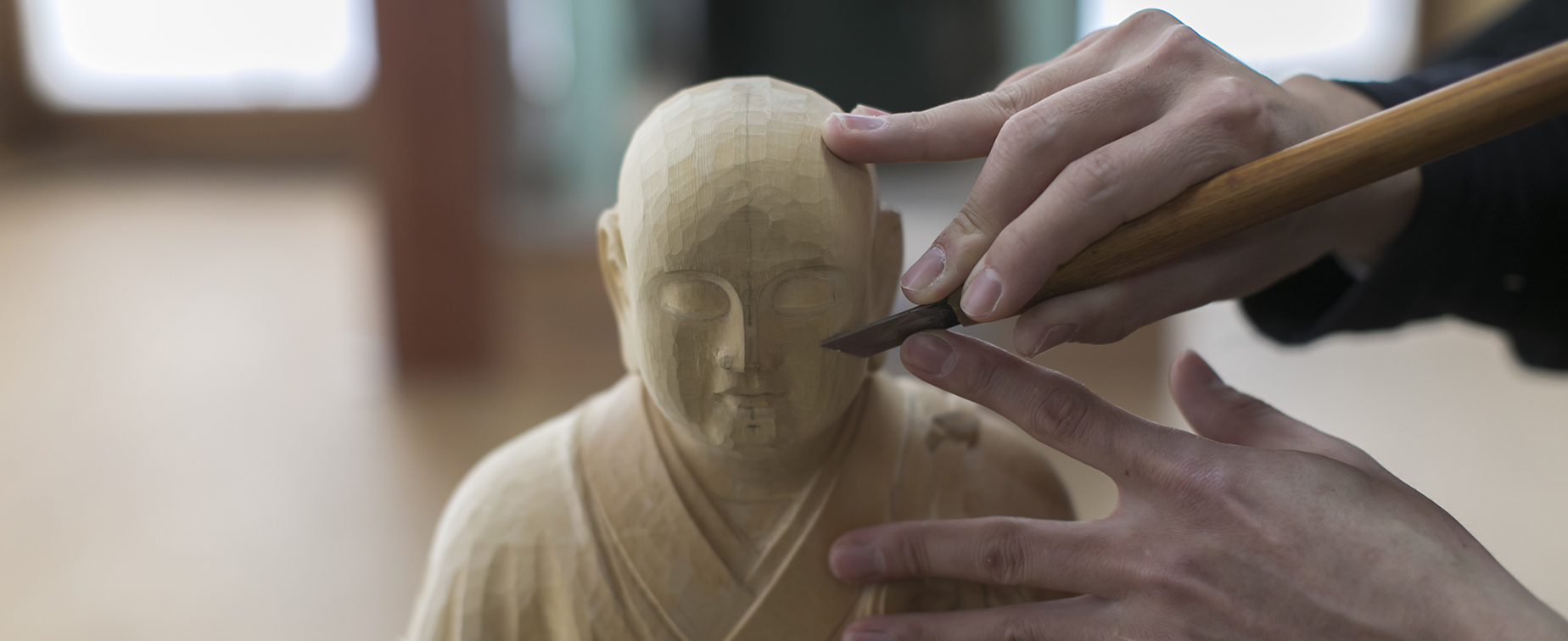
形似人,实非人。
佛教雕塑的创作严格遵循被称为“仪轨”的仪式规则。从面部表情、手指形状到姿态,每一个细节都体现着佛教思想。被称为“佛师”的佛教雕塑家们精益求精,力求以精准而庄严的姿态展现佛陀的教诲。
唯独佛像所穿的袈裟在礼制中鲜有提及。对于必须严格遵守既定规则的佛教雕塑家来说,这是他们少数可以发挥创造力的领域之一。对于袈裟的纹理,无论是流向足部的纹理,还是布料交叠的褶皱,都没有固定的刻画方法。雕塑家左手拿着凿子,右手拿着锤子,反复尝试,在木料上雕刻——如同雕刻真正的衣服,却又不失庄重感。雕塑家游走于庄严与现实之间,以心中佛像为原型进行创作。
宫本学久
佛教雕塑家。1981年出生于京都。高中毕业后,他在美术短期大学和专门学校学习时装设计,从事插画工作,并在京都开始学习佛教雕塑。2015年,他完成了九年的学习,并开设了自己的工作室“宫本工艺”,从事佛像的雕刻和修复工作。

佛教雕塑家的意义
佛教雕塑家宫本岳久向我们展示了他工作室的佛像。
“这是一块在火中被烧得完全变黑的木头。”
“一座寺庙的教友家遭遇火灾,住持委托人制作了一尊佛像以示慰问。整座房子都烧毁了,但中央那根用榉木制成的柱子却保留了下来。我用凿子凿掉了柱子的表面,现在才开始看到里面的释迦(佛)像。”
那是百年以上房屋使用的榉木,所以这棵树的年龄应该超过200年。火焰烧灼后,表面几乎完全碳化,但宫本说,经过仔细的凿刻,一些鲜活的木材开始一点一点显露出来。
宫本结束了约九年的训练,于2015年离开师父独立创作。这是他成为佛教雕塑家以来第一次接受佛像制作委托。
宫本工艺创立后,我第一年主要从事像“牌位”(佛教神位)这样的雕刻项目。作为一名佛教雕刻家,我当然想创作佛像,但佛像创作中也存在着某种命运的因素,所以我只能等待。用烧木雕刻佛像并非易事,但我很高兴独立创作后接到的第一份雕塑委托,对客户来说,就蕴含着强烈的情感意义。在研修结束,以及刚开始独立创作的过程中,我一直在思考创作佛像的意义。我一直在问自己,为什么要雕刻佛像,而我觉得在雕刻这尊佛像的过程中,我会找到答案。”
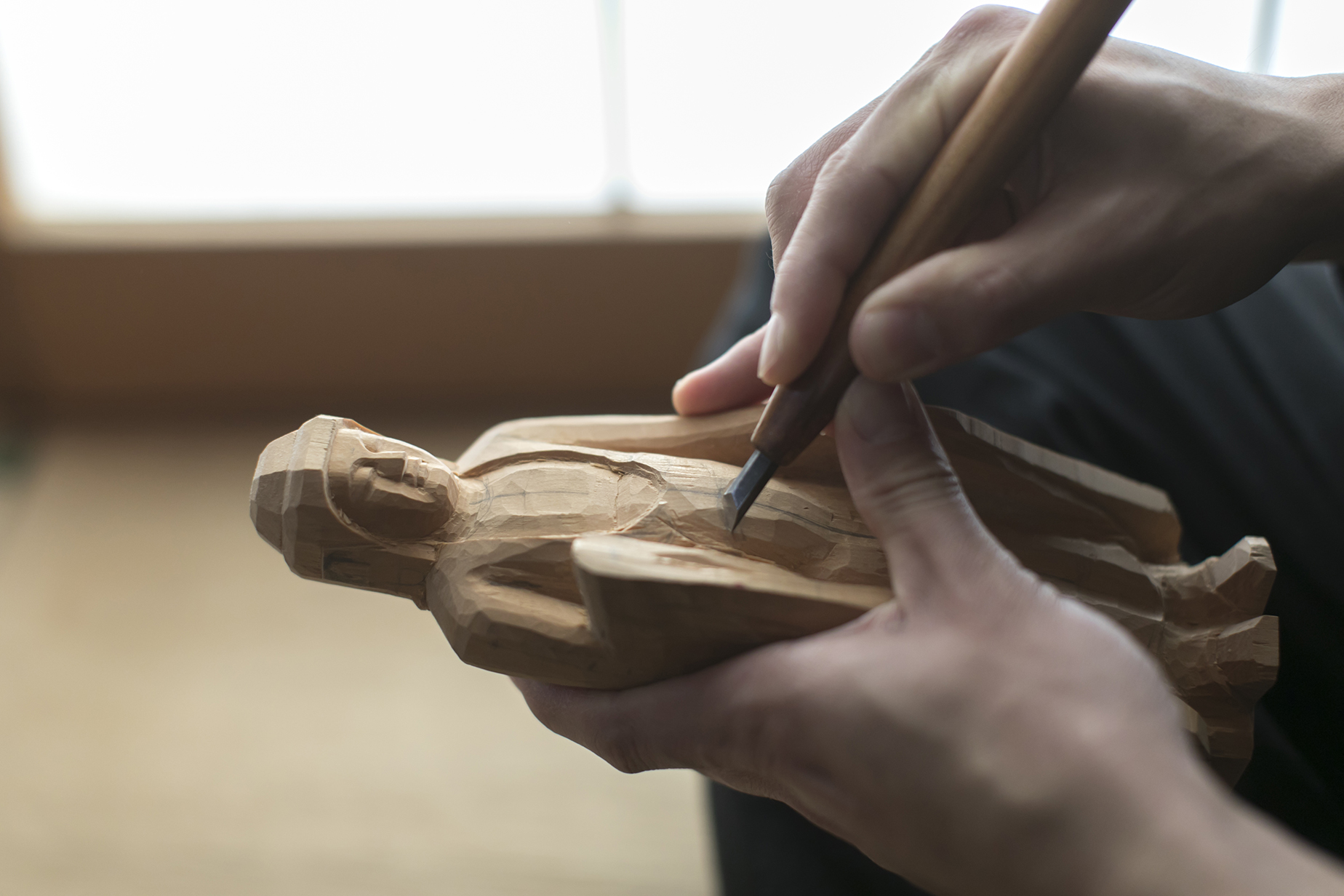
宫本手中托着一尊佛像。他用凿子一丝不苟地雕刻着佛像,赋予其生命力。
时尚与佛像
宫本本名为宫本隆之,在京都南部伏见区长大。他是如何成为佛教雕刻家宫本岳久的?
他一直对时尚充满兴趣。在初中毕业论文集里,年轻的宫本写道,他想成为一名时装设计师。从家乡的一所高中毕业后,他进入了一所艺术专科学校学习时装设计。通过学习艺术和时装表达,他被设计深深吸引,追求形式之美。毕业后,他以奖学金生的身份进入东京的一所职业设计学校学习,从此对时装设计的世界更加着迷。
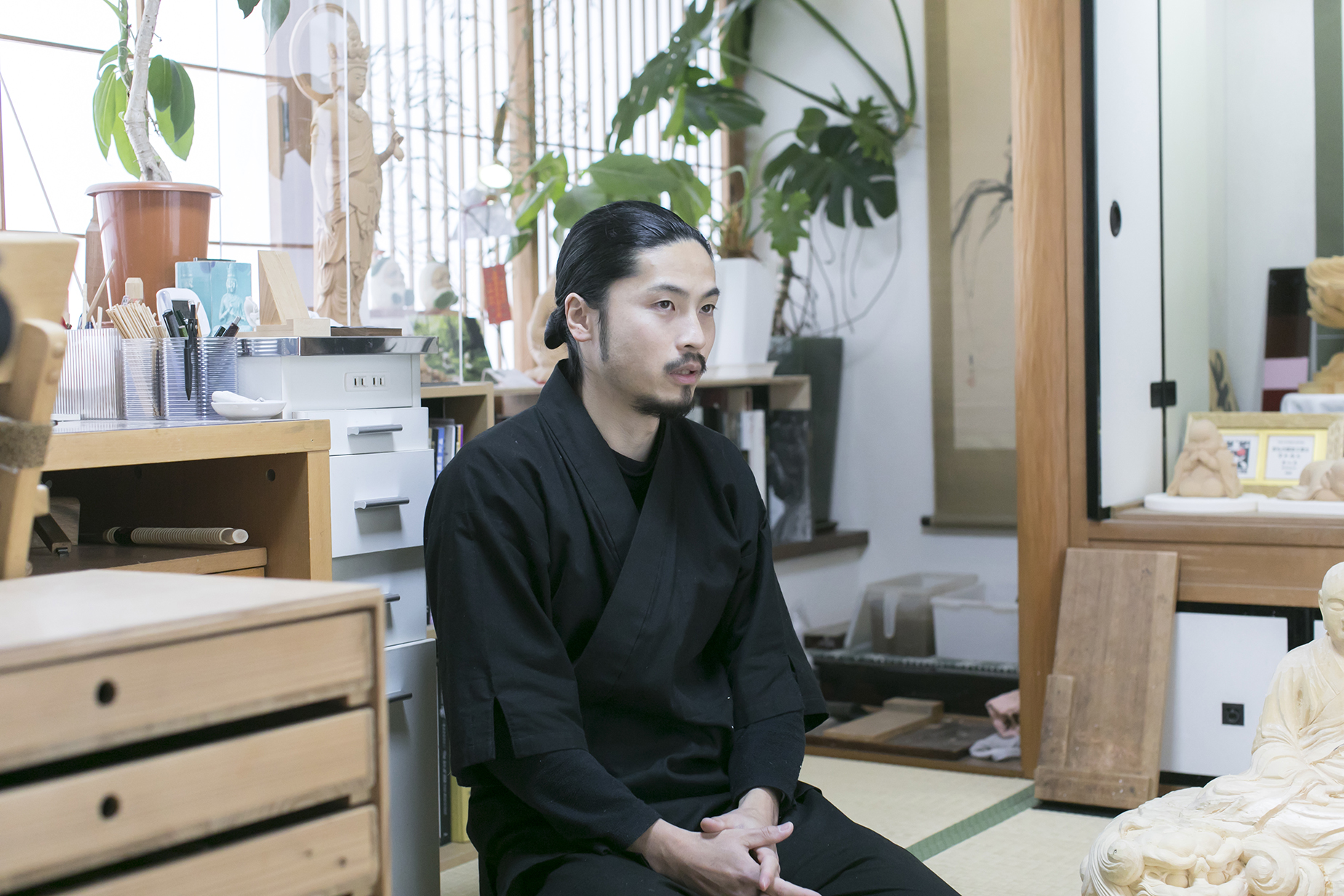
比起实用性,我更喜欢衣服作为艺术品的优美造型。我欣赏当时欧洲高级定制的装饰性时尚,并探索自己的创作方式。我想成为像时装设计师约翰·加利亚诺那样的人。我在专科学校学习了两年时装设计,在职业学校学习了三年,但最终我发现画设计草图比用缝纫机更有趣。最后,我决定从职业学校休学,去画画。
宫本从时装设计起步,后来开始积极创作抽象画,并积极在展览中展示自己的作品。然而,在东京生活,兼职工作和艺术创作的压力开始让24岁的宫本感到压力重重。
“我累了,决定把基地搬到我长大的地方——京都。我一边在一家设计公司打工,一边继续创作自己的作品。就在我逐渐适应的时候,我遇到了我的师傅。”
这是宫本第一次参观佛教雕塑家的工作室。他哥哥带他去帮忙一位需要人手的佛教雕塑家朋友。他看到一尊未完成的七尺(约2.1米)高的十一面观音像。他的哥哥把他介绍给这位大师,让他帮忙上色,这是完成之前最后的几个难关之一。宫本以前对佛教雕塑并不感兴趣,但他很乐意兼职用画笔作画。在接下来的六个月左右的时间里,宫本过着双重生活:白天从事平面设计工作,晚上则在佛像前挥笔作画。

凿子和刨子。随着对理想形状的追求,工具的数量也在不断增加。保养和维护也需要投入大量的时间和精力。
当时,两份工作之间巨大的时间差异让我心烦意乱。一方面是短期内完成的平面设计,另一方面是要创作能够保存数百年的物品。佛像创作既有趣又有深度。我不停地工作,身体疲惫不堪,但每天还是迫不及待地盼望着夜幕降临。那一刻,我无法抑制自己的情感。
宫本曾经对时尚和绘画很感兴趣,但接触到佛教雕塑后,他再也无法满足他了。
“过去发生过什么,未来又会发生什么。有很多事情要考虑,但不知不觉中,我就向师父行礼,请求他收我为徒。我已经被佛教雕塑的魅力所吸引。”
师傅想了想,同意了。25岁才收徒弟,对一个工匠来说,起步太晚了。

工作室内部看起来过于干净整洁,不像是雕塑家的工作场所。
豪华培训
对于佛教雕塑家来说,培训既艰苦又漫长。除了雕刻之外,他们还必须学习绘画、上漆、金箔等佛像制作所需的技艺。此外,修复和修复是佛教雕塑家的主要工作,需要掌握创作新佛像时所不具备的技能。大多数工匠十几岁就进入这个行业,因为他们预计要经历漫长的培训期。宫本25岁开始学徒生涯,而其他工匠也正是在这个年龄结束培训,独立成为佛教雕塑家。
“刚成为学徒的时候,什么都做不了。那是一种无助的感觉。”
宫本不会拿雕刻刀,更不会雕刻。日复一日,他对自己无能为力感到沮丧,只能眼睁睁地看着自己的杰作。
“什么都做不了,却能拿到师傅的钱,真是让人恼火。回想起那段时光,我印象最深的就是心里难受,想向师傅道歉。我什么都不会,所以晚上拼命练习,只为了能多做一件事。一个晚上,我会专注于雕像的手,另一个晚上,我会专注于图案,回忆师傅白天做过的事。”
宫本是师父的第一个徒弟。师父通过传统的训练成为了一名佛教雕塑家,但徒弟必须观察师父的创作,并学习他的技艺。但师父告诉宫本:“我会向你展示所有作品,并解答你的任何问题。所以,赶快提升你的技艺吧。” 师父信守诺言,详细地解释了所有作品。
我想他考虑到了我的年龄。要想有朝一日成为一名独立的佛教雕塑家,最好趁年轻学习技艺。我的训练非常奢侈——我会坐在师父对面,他会把他雕刻的作品交给我。我会继续他的做法,雕刻一点,然后他会当着我的面纠正我的做法。我想,能有幸接受这种训练的佛教雕塑家并不多。我之所以能在九年内达到一定水平,全靠师父的悉心指导。
由于是师父的第一个徒弟,宫本有幸体验了佛教雕塑家的方方面面。他还将从师父那里学到的技艺传授给后来的徒弟,从而得以复习。2015年4月,宫本完成了九年的学徒生涯,离开师父,开始独自创作。

等待修复的佛像部件。清洗后,它们以拆解状态晾干。每一件都是来自过去的典范。
无我
宫本独立后,选择了“Gakyu”(意为“我”)作为他佛教雕塑家的艺名。“我”和“息”两个字组合起来,意为“无我”,这对宫本来说是一种警示,提醒他不要过于自信,因为他有时会与师父发生争执。
我效仿了利休(历史上的茶道大师)的榜样,他以禅宗名言“无名无利”为名,秉持着不求名利的人生原则。佛教雕塑家需要在作品中压抑个人情感,而我的观点却总是会流露出来。我选择这个名字,是为了每次听到这个劝诫时都能想起它。
他选择了松尾大社附近一处安静的住宅区作为自己的工作室和住所。
这里河山环绕,常年湿度稳定。木材管理是佛教雕刻师工作的重要组成部分。我走遍京都寻找合适的地方,最终选择了这里。从学徒时期起,我就想在同一个地方生活和工作。所以,我独立创业的第一个大项目就是找到一个既适合佛教雕刻师工作,又能舒适地与家人共处的地方。
初入宫本工艺工作室,映入眼帘的是井然有序的氛围。工作台上没有摆放任何工具,地板上也没有一丝木屑。
“看到工具或材料被遗漏,我会很在意,所以一有空就会清理。来这里的人都会很惊讶,说‘你真的在这里做事吗?’对一个工匠来说,井井有条很重要,但这么细致或许只是我的性格使然。”
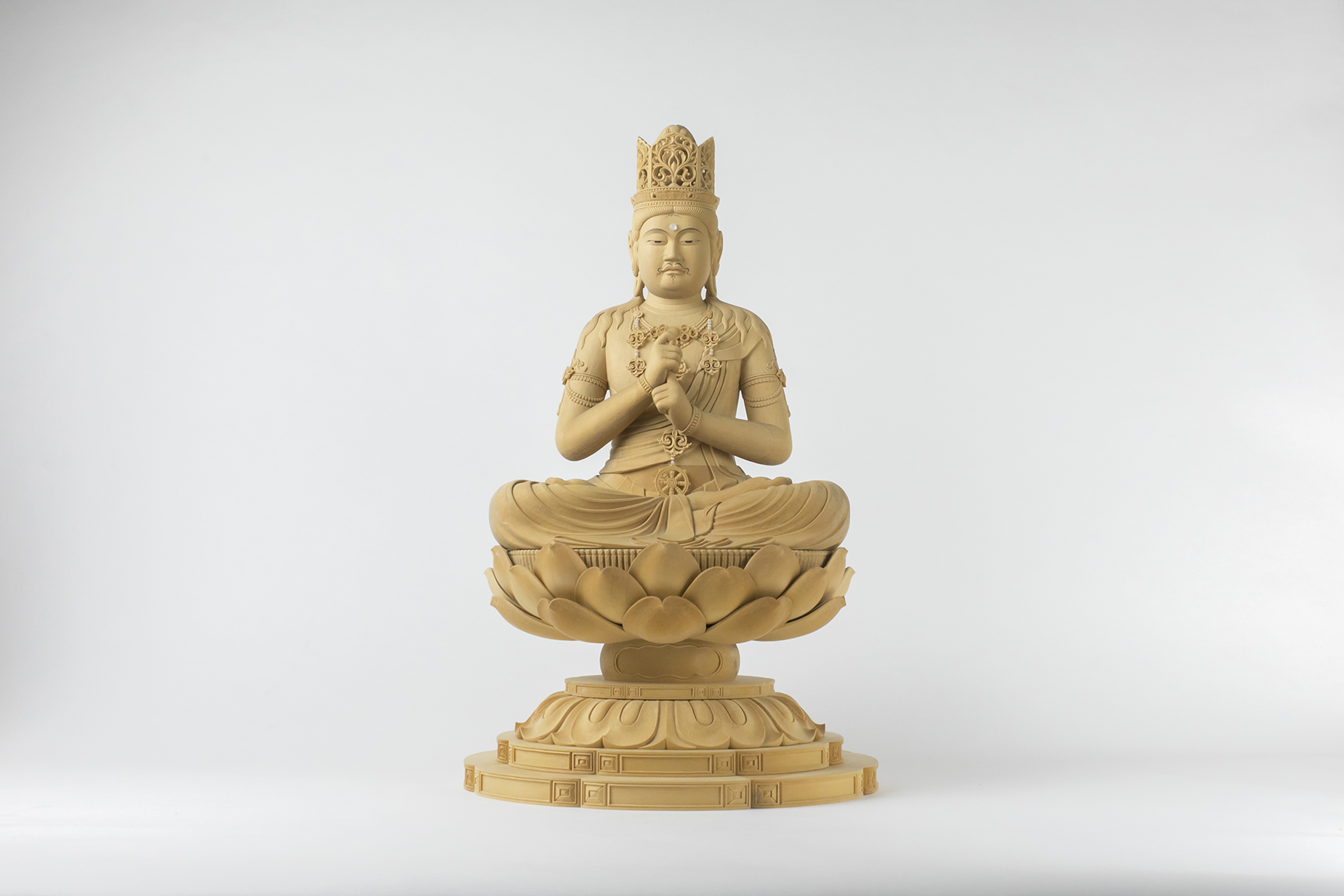
他自己的长袍图案
宫本自独立以来,就开始思考自己的佛像描绘。他说,这让他曾经研究过的时尚中的形式之美,与他心中的佛像交相辉映。
“佛像上布料的垂坠、褶皱,以及它贴合身体的方式——我觉得我或许可以运用我在时装设计方面的经验来表达这些。佛像的形状像人,但它们并非人。我希望通过描绘具有动态感的袈裟来凸显其庄严的威严。”
佛像的制作受“仪轨”的约束。从面部表情、手指形状到姿态,每一个细节都体现着佛教思想。这些规矩的存在是为了保护和传承过去的基本形态。唯独佛像的服饰在仪轨中鲜有提及。因此,佛教雕塑家们拥有充分发挥创造力的空间——就像真实的服饰一样,但又不失庄严感。宫本游走于庄严与现实之间,致力于以他心中的佛像为原型进行创作。
我以为自己一直在从事与时装设计、绘画和平面设计完全不相关的领域,但我错了。任何经验对佛像来说都是有用的,都需要加以利用。我想,这才是我的作品的意义所在。
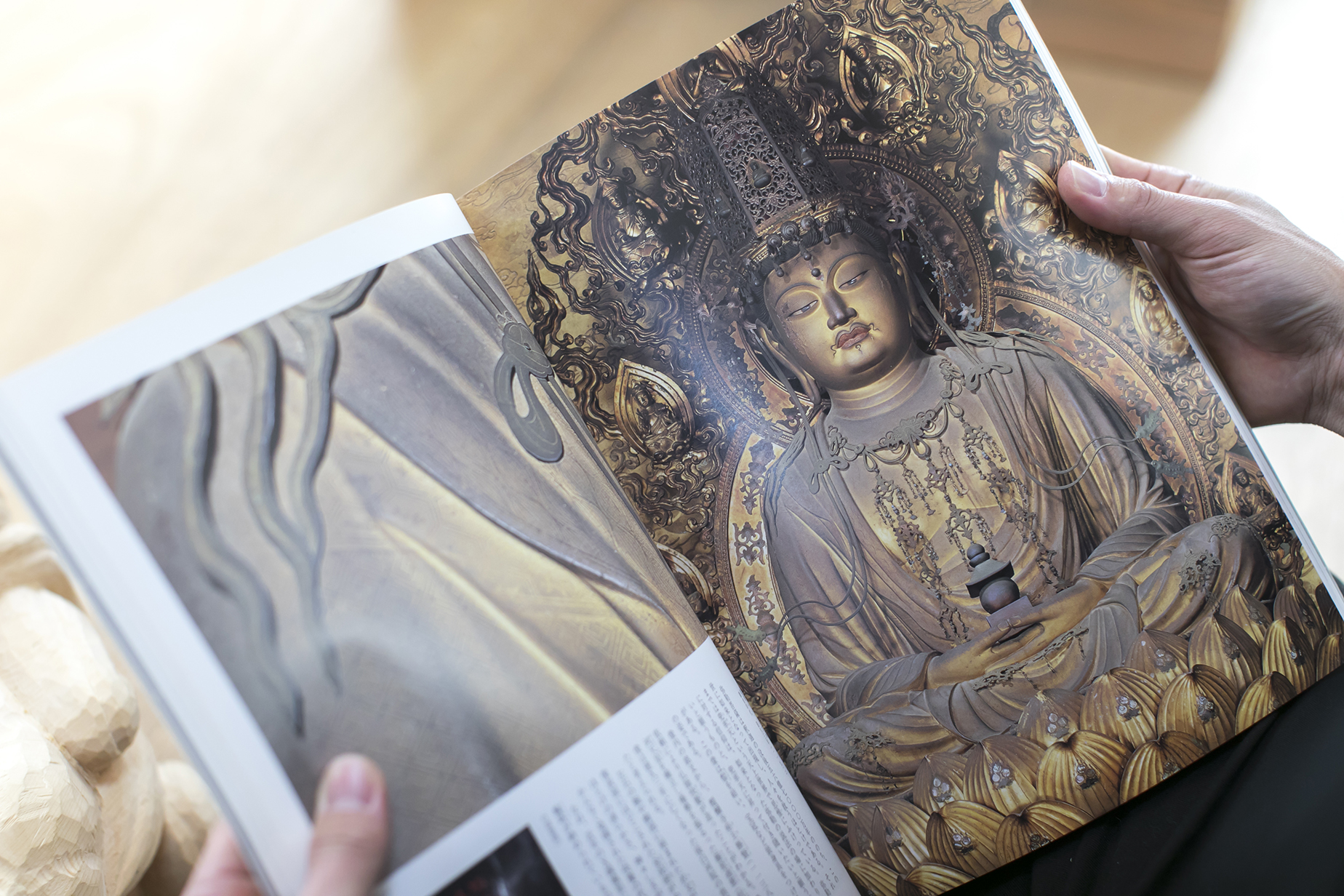
弥勒菩萨坐像,醍醐寺三宝院的主雕像,由凯庆设计。
现代佛教雕塑家的作品
“醍醐寺三宝院的主尊弥勒菩萨坐像。”
当被问及他理想的佛像时,宫本几乎立刻给出了答案。
“从学徒时期起,我就对这尊佛像爱不释手。休息日,我经常带着望远镜去醍醐寺。它的造型统一、气势磅礴,加上快庆(镰仓时代的佛像雕刻家)的服饰,在我看来,它无论从哪方面来说,都是一座堪称完美的佛像。”宫本一边说着,一边翻开一本破旧的画册。
“眼睛和鼻子的对称位置,以及笔直的鼻子——我相信快庆雕像的完美对称性是营造佛像庄严威严的主要因素,我追求的是这一理想。但后来发生了一些事情,彻底颠覆了这种理念。”
那次活动是他学徒生涯即将结束之际,博物馆举办的一次特别展览。得知自己一直仰慕的弥勒菩萨像即将展出,宫本满怀兴奋和期待地参观了展览。然而,他发现原本以为完美的造型略微有些扭曲。
第一次近距离看到的弥勒菩萨,并不像我想象的那么对称。对大多数人来说,这没什么大不了的,但对我来说,这真是个大问题。在醍醐寺和图鉴里,它从远处看起来完全一样。我花了三四个小时站在弥勒菩萨面前,从下往上仰望,闭上一只眼睛等等,但无论我做什么,它就是不对称。在那之前,我一直坚信完美的对称是佛像之美的关键,努力提升自己的技艺,但却迷失了目标。我感觉浑身的力气都耗尽了。
接下来的一年里,宫本无法雕刻佛像。
当他变得独立并且感情终于开始稳定下来后,他接受了委托,用火烧过的木头雕刻佛像。
“我觉得我理想中对称的弥勒菩萨像在我脑海中浮现得过于宏大了。但无论它是否对称,实物都远远超出了我的想象,拥有一种无法用语言形容的神圣感。那是一种震撼人心的存在,与形态之美完全不同。从那时起,我就一直在思考如何才能雕刻出那样的佛像。”
宫本工作时,身边总会放置着醍醐寺弥勒菩萨坐像的照片。
“就连快庆在他的时代也算得上是先锋派。规则固然重要,但更重要的是拥有不受规则束缚的创造力,能够自由地进行雕刻。当我意识到这一点时,我更加坚定了要尝试创作自己的佛像的决心。”

2017年4月,用火烧过的木材雕刻而成的约33厘米高一尺的释迦如来立像终于完工。从接到订单到制作约一年,终于迎来了开光仪式。宫本将这尊立像命名为“光焰”,意为“光之火焰”,希望这块经受住火焰侵蚀、最终化为佛像的榉木,能够守护这家人多年的安康。
“我作为宫本学久制作的第一尊佛像,是一次真正宝贵的经历。它让我领悟到,将自己创作的物品转化为供奉对象,这份工作的意义何在。作为一名工匠,能够参与其中,我感到非常幸运。”
宫本工艺
网站与服务
Facebook: facebook.com/miyamotokougei/
Instagram: instagram.com/gakyu01/

